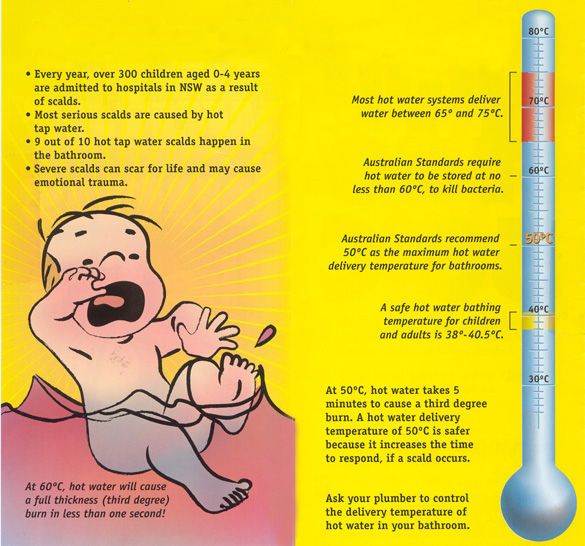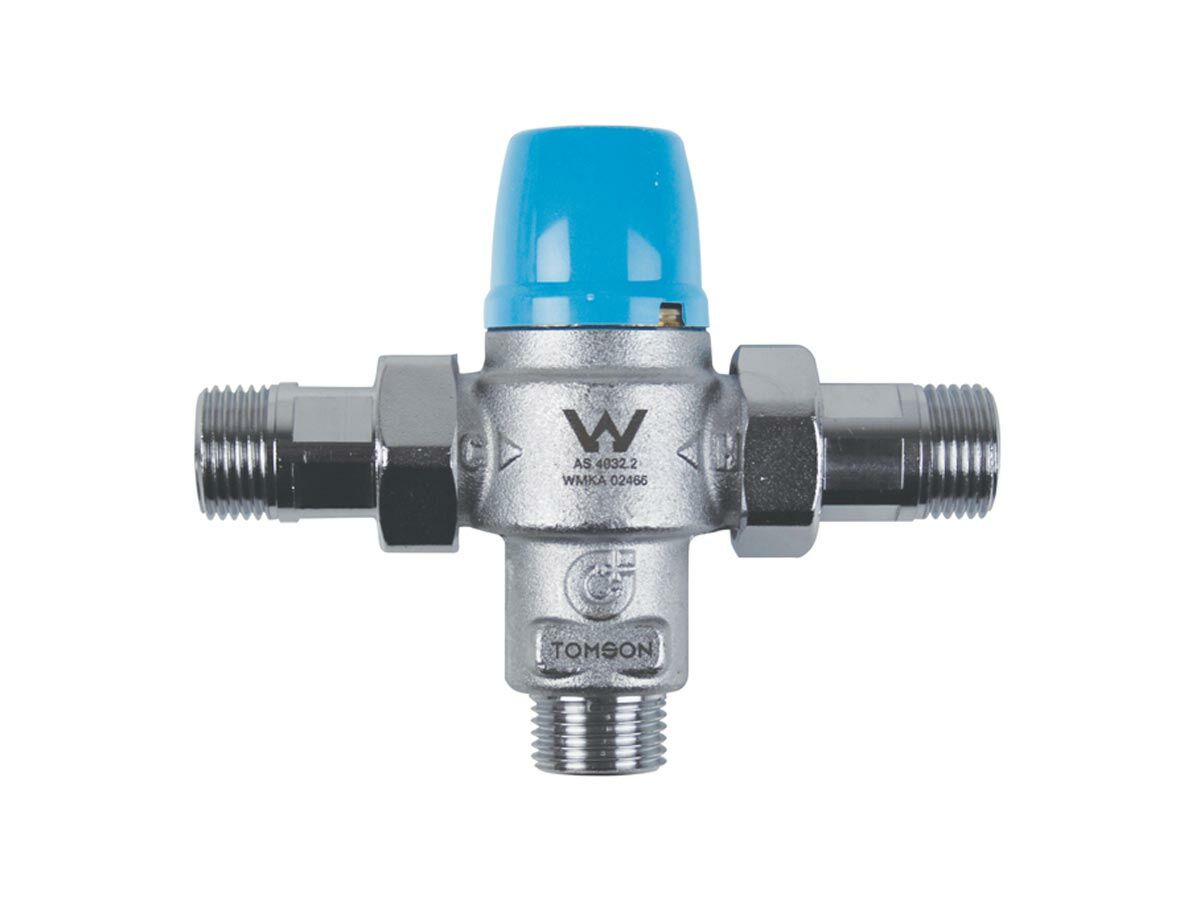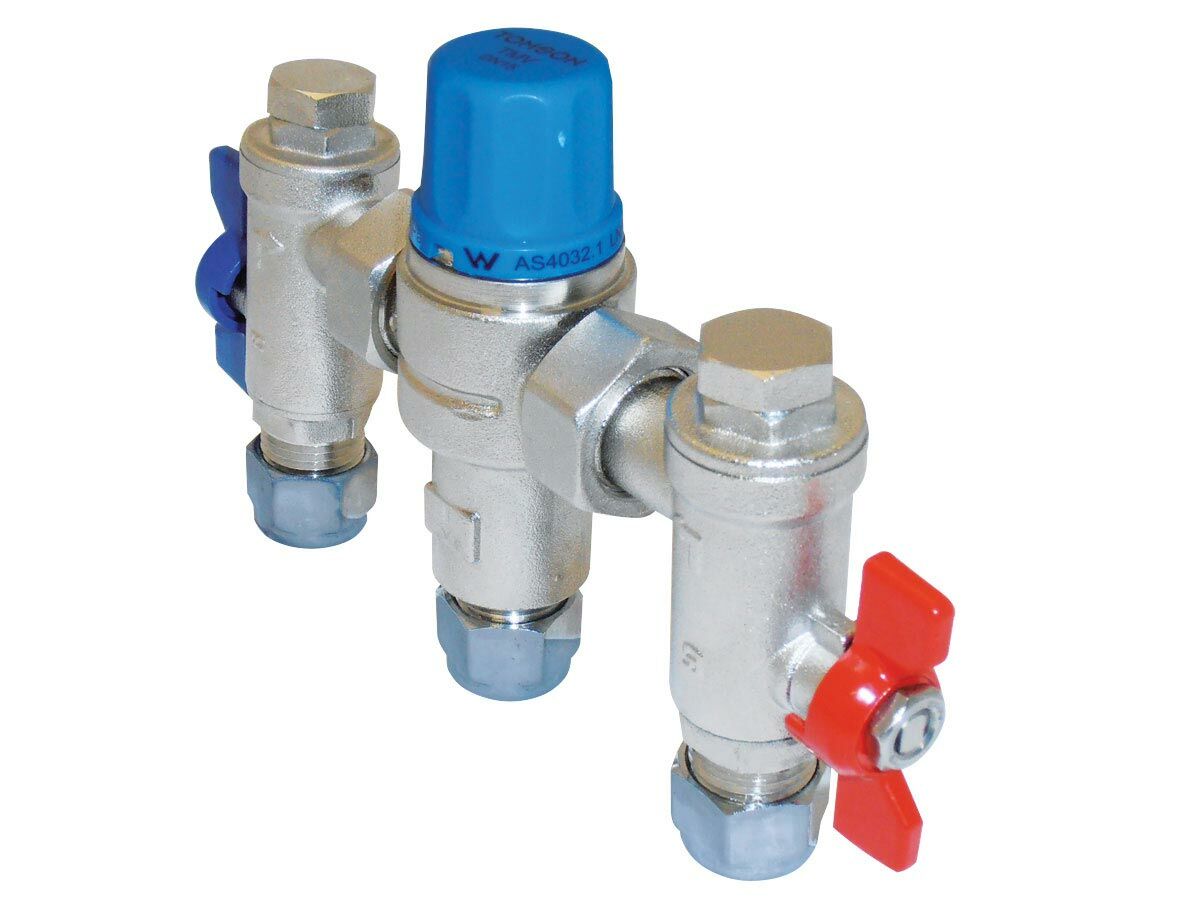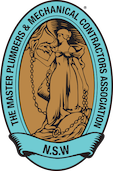Water Scalding
Is your water too hot? Stop Water Scalding
Australian Standards (AS3500) requires the temperature of hot water used for hygiene purposes in childhood centres, schools, & nursing homes or similar facilities for the aged, sick or disabled is not to exceed 43.5°C, & all other classes of buildings i.e. residential water is to be no greater than 50°C.
Did you know it takes less than 1 second for a child to get a third degree from water at 65°C & 5 minutes to cause a third degree burn at 50°C?
Although this legislation is not retrospective its necessity has been highlighted in the coronial inquiry into death due to scalding.
Contact us for further details and ordering information.

Anti Scald Devices
The best way to prevent scalds is to reduce the temperature at the bathroom with an approved anti-scald device such as a Thermostatic Mixing Valve.

Tempering Valve
The tempering valve is used to regulate the set temperature of mixed hot and cold water even when variations occur in the water supply conditions for storage gas and electric hot water units.

Thermostatic Mixing Valve
The thermostatic mixing valves are a safe and reliable way to control water temperature.
NSW Department of Fair Trading stated:
The design, construction, installation, replacement repair, alteration and maintenance of a heated water service must be in accordance with AS/NZS 3500.4.
Therefore, when replacing an existing hot water heater (like for like), the sanitary fixture delivery temperature shall comply with AS/NZS3500.4:2003 Heated Water Services, Clause 1.9.2 Sanitary Fixtures delivery temperature. (A temperature control device must be installed)
Examples of when temperature control devices MUST BE installed are:
- Replacing a hot water heater – regardless of the type of heater or location of the heater.
- When doing new hot water pipe work on an extension, all NEW work is required to be tempered. NOTE: All existing hot water pipe work can remain unchanged.
- When temperature touch pads are being installed, (Touch pads are not an approved temperature control device).
Examples of when a temperature control device is NOT required:
- When there is a factory pre-set hot water unit being installed that supplies ablution areas (eg: bathrooms). This excludes healthcare and aged care buildings, early childhood centres, primary and secondary schools and nursing homes or similar facilities for the aged, the sick, children or people with disabilities etc. Refer to AS/NZS3500.4:2003 1.9.2 Sanitary fixtures delivery temperature
- When doing maintenance only on the valves to a heater (eg: replacing duo valve, control vales and the like, or TPR valves etc). Note: In all other areas other than ablutions, there are no temperature requirements, but it is highly recommended you discuss any requirements with your customer, BEFORE any installation work takes place
Reference:
AS NZS 3500.1:2003 Plumbing and Drainage, Part 4 Heated Water Services
Plumbing Code of Australia 2013 Part B2
To help clarify when a temperature control device is require to be installed refer to the following chart
Heated water supply
replacement/additions scenario
Note: Applies to bathroom renovation including the replacement and or repositioning of fixtures and fittings
Temperature Control Device
Required
Additional Comment
Replacement of an existing heater with [like for like ]new heater
Yes
Replacement of an existing heater with an alternate model, size or heat source
Yes
Repositioning of an existing heater to a new location
Yes
Replacement of any associated valves, elements thermostats etc.
No
Excludes the replacement of any existing control device
Replacement of all of the heaters that are installed in a manifold system
Yes
Replacement of one or more heaters, but not all of the heaters in a manifold multiple bank of heaters
No
Replacement of a heater unit where currently a touch pad temperature control unit is installed
Yes
A newly built ablution areas, connecting to the existing heated water supply, but no work is carried out on the existing heater and there is no existing temperature control device installed
Yes
Only the new ablution points installed are required to be tempered but the whole of
system maybe tempered
Replacement of an existing plumbing fixture or fitting and there is no existing temperature control device
No
example: replacement of a basin tap
Replacement of all fixtures within an existing bathroom and the existing heated water supply has no temperature control device installed
Yes
Only the replaced ablution points installed
are required to be tempered but the whole of system maybe tempered
Replacement of solar collection panel
only
No
Tempering Valves and Thermostatic Mixing Valves work by mixing hot and cold water together to reduce the temperature of the hot water.
The Australian Standard (AS3500) that requires that these valves be installed also requires that they are tested at least annually in a commercial & domestic installation, & monthly in an aged or childcare facility by a suitably trained person. This is to ensure that the water temperature is correct & the valve is functioning correctly.
After testing a certificate is provided to the owner as proof that the valve has been tested. has plumbers that are trained to carry out this specialist work.
Contact us for further details and ordering information.


